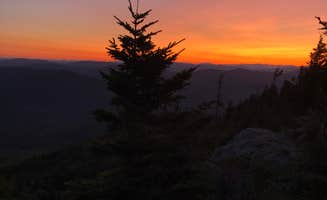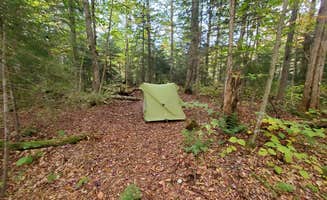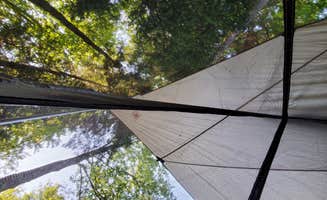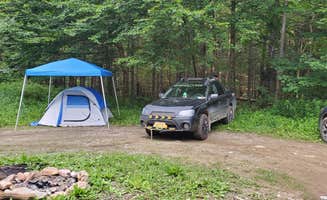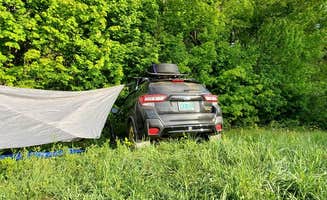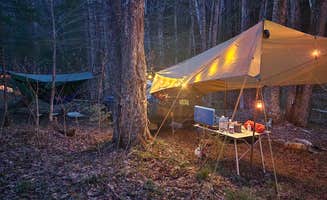Primitive camping near Brant Lake, New York centers around undeveloped Adirondack Forest Preserve lands where elevations range from 800 to 2,800 feet. Summer daytime temperatures typically reach 75-85°F, while nights cool to 50-60°F even in July and August. The area contains several unmarked dispersed sites on public forest lands that require proper navigation and preparation.
What to do
Swimming opportunities: At Crane Mountain Pond Campsite, visitors can enjoy water activities after a challenging hike. "After a short hike up steep crane mountain we watched the beautiful sun set. One of the nicest places I've camped at," notes camper T K.
Hiking trails: Multiple trailheads access the surrounding mountains and valleys. The Clark Brook Trail near Green Mountain Forest connects to the Appalachian Trail/Long Trail system. "Clark Brook Trail is a 3 mile hike connecting with the AT/LT," reports Tim M., providing options for day hiking from your campsite.
Wildlife viewing: The remote nature of dispersed camping areas provides excellent wildlife observation opportunities. At Green Mountain National Forest FR207, one winter camper reported: "Woke up to two moose nearby the morning I was leaving." Early mornings offer the best wildlife viewing times, particularly around water sources.
What campers like
Waterfront sites: Many primitive campsites feature water access. At Cod Pond Dispersed Pull-Off, one camper noted, "There is a river down the hill from the campsite which helps keep it fairly cool at night." These water features provide natural cooling and ambient sound.
Privacy: Secluded sites offer isolation from other campers. "The site has it's own private road... There is a firepit at the site and plenty of space for multiple tents," reports Taylor A. about Cod Pond. Most sites are spaced to provide visual and auditory privacy from neighboring campsites.
Stargazing: The minimal light pollution in the Adirondacks creates exceptional night sky viewing. "Beautiful sunsets, night skies and scenery. Extremely calm and peaceful," reports Phil J. about winter camping at Green Mountain National Forest. Clear nights reveal the Milky Way and occasional meteor showers.
What you should know
Vehicle requirements: Many access roads demand appropriate vehicles with adequate clearance. "This is not a place to go without at least 9" of ground clearance," warns Miccal M. about forest roads. Several areas feature uneven terrain with rocks and seasonal mud holes.
Seasonal considerations: Conditions vary dramatically by season. For Ward Brook Campsite, accessibility changes with weather. "Great campsite with a nice lean-to. Fire pit, picnic table, and a privy. A bit further you will find some tent spots too. Plenty of water around," notes Alex R., highlighting facilities that become important during inclement weather.
Navigation challenges: Many sites lack clear markers and can be difficult to locate. "The directions in the app are accurate -but do keep in mind that the campsite is down a dirt road which is well hidden from the main road if you aren't paying close attention," advises Taylor A. Physical maps are essential as cell service remains unreliable.
Tips for camping with families
Site selection: Choose locations with natural features that entertain children. At Bear Slide in Lake George Wild Forest, the rocky terrain provides natural exploration opportunities. "It was rocky getting there but super super remote - zero service. Great space for my jeep and honestly you could fit a LARGE RV," notes Brendan M.
Weather preparation: Temperature fluctuations require layered clothing and proper sleeping gear. "The site is mostly shaded-the sun shines through a bit but not much," reports a camper at Cod Pond, indicating the need for warmer clothes even in summer months.
Water considerations: Natural water sources require treatment before consumption. "Plenty of water around," notes a Ward Brook camper, but this water requires filtering or boiling before drinking. Pack multiple methods of water purification as backup.
Tips from RVers
Size limitations: Most dispersed sites accommodate only small trailers or truck campers. "A car is not recommended. Possible to turn around but you definitely need a smaller SUV," advises Taylor A. about Cod Pond Pull-Off. Standard-size RVs cannot access most primitive sites.
Alternative parking: Some areas offer parking at trailheads with tent camping opportunities nearby. "The parking lot at the end of Crane Pond Road is relatively small but can fit at least 6 vehicles," notes one visitor, providing options for those with larger vehicles who are willing to hike to their camping location.
Ground conditions: Sites rarely offer level parking. "If you're considering a spot in Vermont to camp, come here! Also, make sure your car has a bit of clearance as some sports have dips in the ground," recommends Amanda about nearby Green Mountain Forest options, highlighting the need to check terrain before attempting access.


